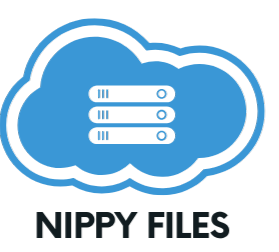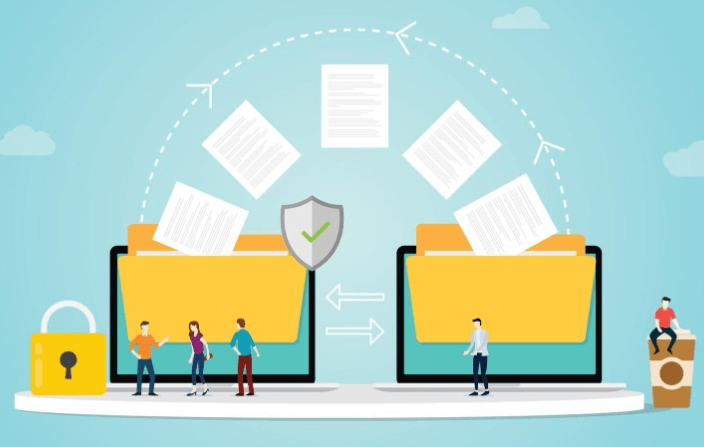
Top Free File Sharing Platforms & How NippyFiles Compares
August 20, 2025
Best File Sharing Services of 2025—Why NippyFiles Stands Out
August 20, 2025In today’s digital-first world, sharing files is an everyday necessity—whether you’re collaborating with team members, sending client deliverables, or sharing high-resolution media with friends and family. However, one of the most common challenges people face is large file sharing. Standard email attachments often have size limits (usually 25MB or less), making it difficult to transfer large documents, videos, design files, or datasets.
Fortunately, technology has evolved to offer fast, secure, and user-friendly solutions for transferring large files. In this comprehensive guide, we’ll walk you through 7 simple and effective methods for sharing large files quickly and securely. Whether you’re a professional, student, or casual user, these strategies will help you overcome file size limitations and streamline your digital communication.
Why Large File Sharing Is a Challenge
Before diving into the solutions, it’s important to understand why large file sharing can be tricky. Most traditional communication tools—like email and instant messaging apps—impose strict file size limits to prevent server overload and ensure fast delivery. For example:
- Gmail limits attachments to 25MB
- Outlook allows up to 20MB per email
- WhatsApp restricts media to 100MB
These limitations make it nearly impossible to share large video files, high-resolution photos, CAD designs, or compressed project folders. Moreover, uploading and downloading massive files can be slow without proper tools, and security is often a concern when sending sensitive data.
This is where dedicated file-sharing solutions come into play. Let’s explore seven proven methods that make large file sharing easy, fast, and secure.
1. Use Cloud Storage Services (Google Drive, Dropbox, OneDrive)
One of the most popular and reliable ways to share large files is through cloud storage platforms. Services like Google Drive, Dropbox, and Microsoft OneDrive allow you to upload files to the cloud and share them via a secure link.
How It Works:
- Upload your file to your cloud storage account.
- Right-click the file and select “Get link” or “Share.”
- Adjust permissions (view-only, edit access, etc.).
- Copy the link and send it via email, messaging apps, or social media.
Benefits:
- No size limits (within storage limits): Most services offer 15GB (Google Drive) to 2TB (Dropbox Professional) of storage.
- Easy access: Recipients don’t need an account to view or download the file.
- Version control: Track changes and maintain file history.
- Security: Files are encrypted in transit and at rest.
Tips:
- Compress large folders into ZIP or RAR format before uploading to save space.
- Set expiration dates on shared links for sensitive files.
- Use two-factor authentication to protect your cloud account.
Best For: Collaborative teams, frequent file sharers, and users already using cloud ecosystems.
2. Leverage File Transfer Services (WeTransfer, Send Anywhere)
If you need to send a large file quickly without creating an account, specialized file transfer services like WeTransfer and Send Anywhere are ideal.
WeTransfer:
- Free users can send files up to 2GB.
- Pro version allows transfers up to 20GB.
- Files are stored for 7 days.
- Simple interface: drag, drop, enter recipient email, and send.
Send Anywhere:
- Supports transfers up to 10GB.
- Uses peer-to-peer (P2P) technology for faster speeds.
- Share via link or 6-digit key.
- No registration required.
Benefits:
- No installation needed – works directly in your browser.
- Fast upload and download speeds.
- Cross-platform compatibility – works on desktop and mobile.
Tips:
- Use WeTransfer Pro for password protection and branding.
- For ultra-sensitive files, avoid public links and use password-protected transfers.
Best For: One-time large file transfers, creatives, and non-tech-savvy users.
3. Compress Files Before Sharing
Sometimes, the best way to handle a large file is to make it smaller. File compression tools like WinRAR, 7-Zip, or macOS Archive Utility can significantly reduce file size without losing quality (using lossless compression).
How to Compress:
- Select the file or folder.
- Right-click and choose “Add to archive” (WinRAR) or “Compress” (macOS).
- Choose ZIP or RAR format.
- Upload the compressed file using any sharing method.
Benefits:
- Reduces file size by up to 50–90%, depending on content.
- Bundles multiple files into one for easier sharing.
- Can add password protection for security.
Limitations:
- Compression doesn’t work well for already compressed files (e.g., MP4, JPG, MP3).
- Requires the recipient to have extraction software (though ZIP is widely supported).
Tip:
Use “split archive” feature to break large files into smaller parts (e.g., 100MB each) for email or platform compatibility.
Best For: Sending multiple files or reducing size for email compatibility.
4. Use FTP or SFTP for Professional Large File Sharing
For businesses, developers, or IT professionals, File Transfer Protocol (FTP) or Secure FTP (SFTP) offers a powerful solution for transferring large volumes of data.
How It Works:
- Set up an FTP server (using tools like FileZilla Server or cloud-based FTP services).
- Connect via an FTP client (e.g., FileZilla, WinSCP).
- Upload files and provide access credentials to recipients.
Benefits:
- High-speed transfers for large datasets.
- Automated workflows and scripting support.
- Secure with SFTP/FTPS (encrypted connections).
- Ideal for recurring file transfers (e.g., backups, website updates).
Downsides:
- Requires technical knowledge to set up and manage.
- Not as user-friendly for non-technical recipients.
Alternatives:
Consider managed services like AWS S3, Google Cloud Storage, or Backblaze B2 that offer FTP-like access with modern interfaces.
Best For: Developers, system administrators, and enterprises.
5. Share via Peer-to-Peer (P2P) Apps
Peer-to-peer file sharing apps like Snapdrop, Send Anywhere, and Feem enable direct file transfers between devices without uploading to a server.
How It Works:
- Both sender and receiver connect to the same Wi-Fi network (or use internet-based P2P).
- Open the app or website.
- Drag and drop the file to send.
- Receiver accepts and downloads instantly.
Benefits:
- Extremely fast—no middle server involved.
- No file size limits (limited only by device storage and network).
- High privacy—files aren’t stored on third-party servers.
Limitations:
- Requires both parties to be online simultaneously.
- Less convenient for long-distance or asynchronous sharing.
Popular Tools:
- Snapdrop.net – browser-based, no app needed.
- Send Anywhere – works across devices with a 6-digit code.
- Feem – LAN and internet file sharing with chat support.
Best For: Local transfers, quick sharing between colleagues, or home networks.
6. Use Email with Cloud Integration
Many email platforms now integrate with cloud storage, allowing you to send large files indirectly. For example:
- Gmail + Google Drive: Attach files from Google Drive directly in Gmail. Recipients receive a link instead of the attachment.
- Outlook + OneDrive: Insert files from OneDrive with sharing permissions.
- Apple Mail + iCloud Drive: Share large files via iCloud links.
How to Use:
- Compose a new email.
- Click the “Insert from Drive” (Google) or “OneDrive” button.
- Select the file and choose sharing settings.
- Send the email—the recipient gets a secure link.
Benefits:
- Seamless integration with tools you already use.
- Avoids email attachment limits.
- Maintains professional appearance.
Tips:
- Always set appropriate permissions (e.g., “Anyone with the link can view”).
- Remove access after the file is no longer needed.
Best For: Professionals who rely on email for communication.
7. Use Enterprise File Sharing Platforms (Box, Citrix ShareFile)
For organizations dealing with sensitive or regulated data, enterprise-grade file sharing platforms offer enhanced security, compliance, and tracking.
Top Platforms:
- Box: Offers secure sharing, workflow automation, and integration with Slack, Zoom, and Office 365.
- Citrix ShareFile: Designed for legal, financial, and healthcare industries with audit trails and encryption.
- Egnyte: Combines cloud and on-premise storage with AI-powered security.
Key Features:
- End-to-end encryption
- Detailed access logs and audit trails
- Customizable permissions and expiration dates
- GDPR, HIPAA, and SOC 2 compliance
Benefits:
- Ideal for sharing large files containing confidential information.
- Scalable for teams and departments.
- Integrates with CRM, ERP, and productivity tools.
Considerations:
- Higher cost compared to consumer tools.
- May require training for team members.
Best For: Legal firms, healthcare providers, financial institutions, and large enterprises.
Bonus Tips for Secure and Efficient Large File Sharing
To make the most of any file-sharing method, keep these best practices in mind:
- Always Use Encryption: Ensure files are encrypted during transfer and storage.
- Set Expiration Dates: Automatically revoke access after a set period.
- Add Password Protection: Especially for sensitive documents.
- Verify Recipient Emails: Prevent accidental sharing with the wrong person.
- Monitor Transfer Status: Use services that notify you when the file is downloaded.
- Avoid Public Links for Sensitive Data: Use invite-only or password-protected sharing.
- Keep Software Updated: Protect against vulnerabilities in file-sharing apps.
Conclusion: Choose the Right Method for Your Needs
Large file sharing doesn’t have to be a headache. With the right tools and strategies, you can transfer even the biggest files quickly, securely, and effortlessly. Whether you’re an individual user, a creative professional, or part of a large organization, there’s a solution that fits your workflow.
Here’s a quick recap of the 7 methods:
By understanding your specific needs—such as file size, frequency of sharing, recipient tech-savviness, and security requirements—you can choose the most effective method for large file sharing.
Don’t let file size slow you down. Explore these tools, test a few options, and find the one that works best for your daily digital life. With the right approach, sharing large files can be as easy as sending a text message.




